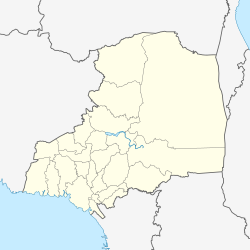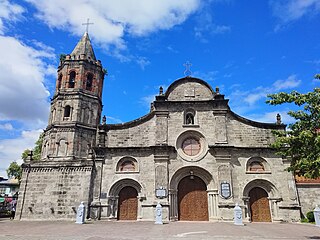
Bulacan, officially the Province of Bulacan, is a province in the Philippines located in the Central Luzon region. Its capital is the city of Malolos. Bulacan was established on August 15, 1578, and part of the Metro Luzon Urban Beltway Super Region.

Bulakan, officially the Municipality of Bulakan, is a 1st class municipality in the province of Bulacan, Philippines. According to the 2020 census, it has a population of 81,232 people.

Malolos, officially the City of Malolos, is a 3rd class component city and capital of the province of Bulacan, Philippines. According to the 2020 census, it has a population of 261,189 people. It is the capital city of the province of Bulacan as the seat of the provincial government.

Angat, officially the Municipality of Angat, is a 1st class municipality in the province of Bulacan, Philippines. According to the 2020 census, it has a population of 65,617 people.

Balagtas, officially the Municipality of Balagtas, is a 1st class municipality in the province of Bulacan, Philippines. According to the 2020 census, it has a population of 77,018 people. The municipality is 30 kilometers (19 mi) from Manila and is 15 kilometers (9.3 mi) from Malolos City.

Hagonoy, officially the Municipality of Hagonoy, is a 1st class municipality in the province of Bulacan, Philippines. According to the 2020 census, it has a population of 133,448 people.
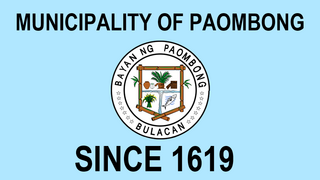
Paombong, officially the Municipality of Paombong, is a 3rd class municipality in the province of Bulacan, Philippines. According to the 2020 census, it has a population of 55,696 people.

Plaridel, officially the Municipality of Plaridel, formerly known as Quingua, is a 1st class municipality in the province of Bulacan, Philippines. According to the 2020 census, it has a population of 114,432 people.

Our Lady of Mount Carmel Parish, also known as Barásoain Church is a Roman Catholic church built in 1888 in Malolos, Bulacan, Philippines. It is under the jurisdiction of the Diocese of Malolos and is about 42 kilometers (26 mi) from Manila. Having earned the title as the "Cradle of Democracy in the East, the most important religious building in the Philippines", and the site of the First Philippine Republic, the church is proverbial for its historical importance among Filipinos.

The Diocese of Malolos is a Latin Church ecclesiastical jurisdiction or diocese of the Catholic Church in the Philippines, encompassing the whole Province of Bulacan and Valenzuela City in metropolitan Manila and is a suffragan to the metropolitan Archdiocese of Manila. The mother church of the Diocese is the Cathedral-Basilica of the Immaculate Conception located in Malolos City, Bulacan. The Blessed Virgin Mary, under the title of Immaculate Conception is the principal patroness of the diocese.
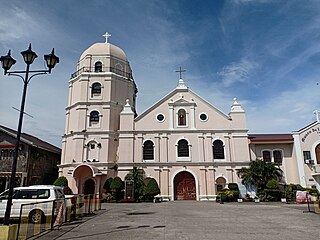
The San Pascual Baylón Parish and National Shrine of Nuestra Señora de la Immaculada Concepcion de Salambao, commonly known as Obando Church, is a Roman Catholic church located in the municipality of Obando in the province of Bulacan, Philippines. It is under the jurisdiction of the Diocese of Malolos.
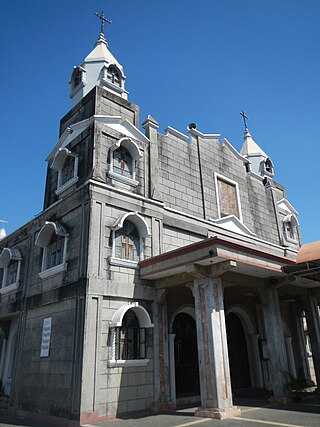
Santo Cristo Sub-Parish Church, locally known as the Bisita ng Mahal na Señor Santo Cristo de Baliuag and Apo Kristo Chapel, is the oldest "ermita" (chapel) in Baliuag, Bulacan, Philippines. The visita is under the jurisdiction of the Diocese of Malolos and is bounded by the cities of San Fernando and Mabalacat in Pampanga, and Balanga in Bataan. At present, its mother Parish, the Saint Augustine Parish Church of Baliuag, Bulacan, has 4 parishes.

The Diocesan Shrine and Parish of Saint Augustine, commonly known as Baliwag Church, is a Roman Catholic church located in Plaza Naning at the poblacion of Baliwag, in Bulacan province, Philippines. The church is a parish church of the Diocese of Malolos, which is a suffragan of the Archdiocese of Manila.

Santa Monica Parish Church, commonly known as Angat Church, is a Roman Catholic church in Angat, Bulacan, Philippines. It is under the jurisdiction of the Diocese of Malolos and is one of the oldest churches in Bulacan province, dating back to 1758. It displays Baroque architectural characteristics and features ceiling paintings which resemble those in the Sistine Chapel.

The Diocesan Shrine and Parish of Saint John the Baptist, also known as the San Juan Bautista Parish Church and commonly known as Calumpit Church, is a 17th-century, Roman Catholic, baroque church located in Calumpit, Bulacan, Philippines. The parish church, under the patronage of Saint John the Baptist, belongs to the Diocese of Malolos under the Vicariate of Saint James the Apostle.

The Diocesan Shrine and Parish of San Isidro Labrador, commonly known as Pulilan Church, is a 19th-century Baroque Roman Catholic church located at Brgy. Poblacion, Pulilan, Bulacan, Philippines. The parish church, dedicated to Saint Isidore, the Laborer, is under the Diocese of Malolos. The church is popular for being the site where water buffalos are made to kneel as tribute to the feast day of the patron saint. Like the Saint Augustine Parish from the nearby town of Baliuag, the church is also known for featuring one of the longest Holy Week Processions with at least 110 floats.

San Ildefonso de Toledo Parish Church, commonly known as Guiguinto Church, is an 18th-century, Baroque Roman Catholic church located along the MacArthur Highway, Brgy. Poblacion, Guiguinto, Bulacan, Philippines. The parish church, under the aegis of Saint Ildephonsus, Bishop of Toledo, is under the jurisdiction of the Diocese of Malolos. The church is connected to St. Martin de Porres Catholic school of Guiguinto, a private school in Guiguinto.

Our Lady of Mount Carmel Parish, also known as Nuestra Señora del Carmen Parish, is a Roman Catholic church situated in Km. 38, Barangay Pulong Buhangin, Santa Maria, in the province of Bulacan, Philippines. It is under the jurisdiction of the Diocese of Malolos and within the Vicariate of Santa Maria.

Santiago Apóstol is a Roman Catholic parish church located in Liétor, in the Community of Castilla–La Mancha, Spain.

